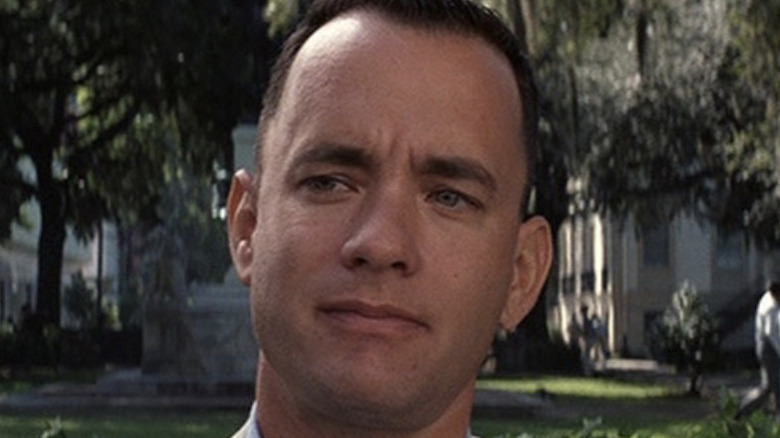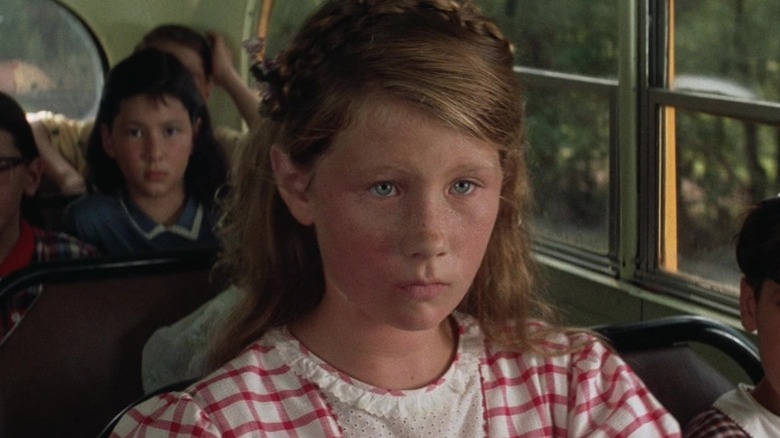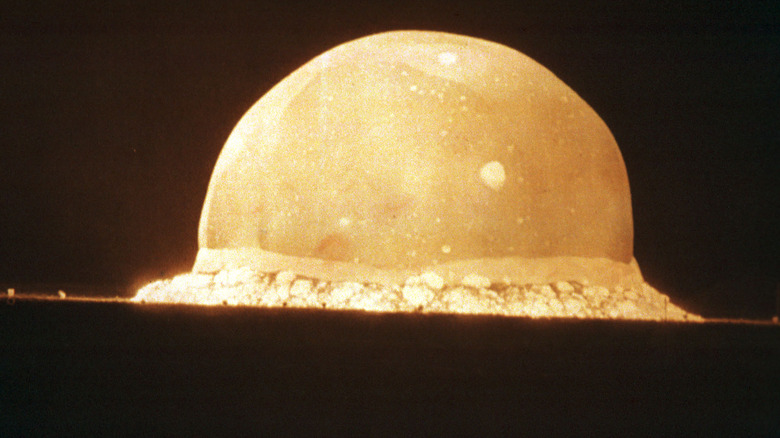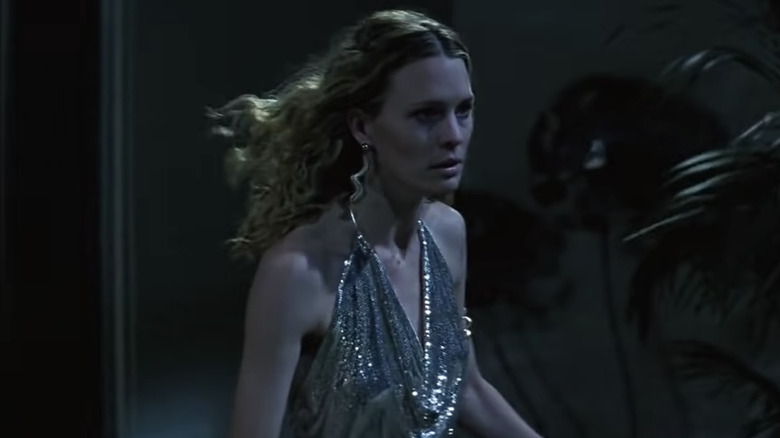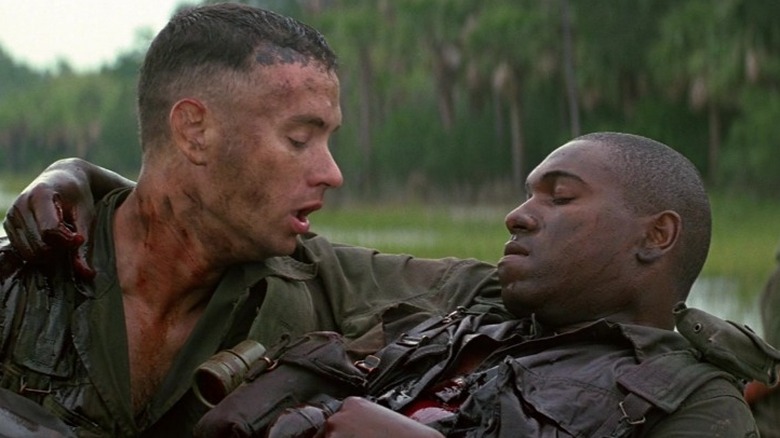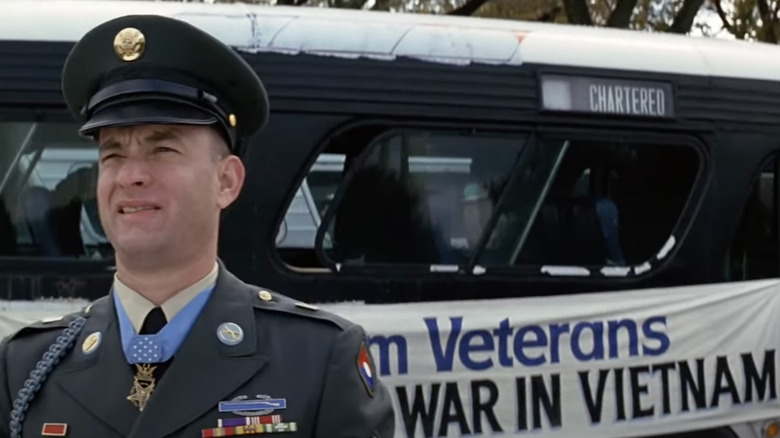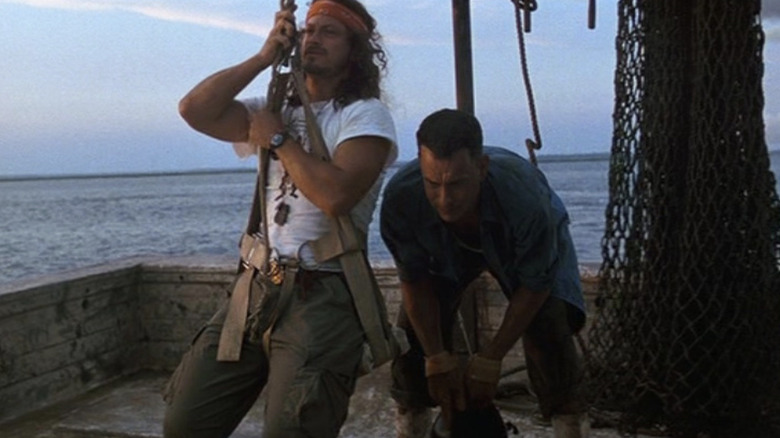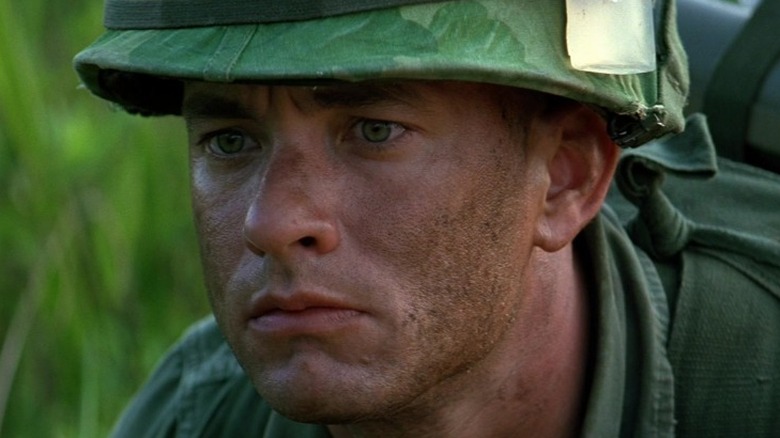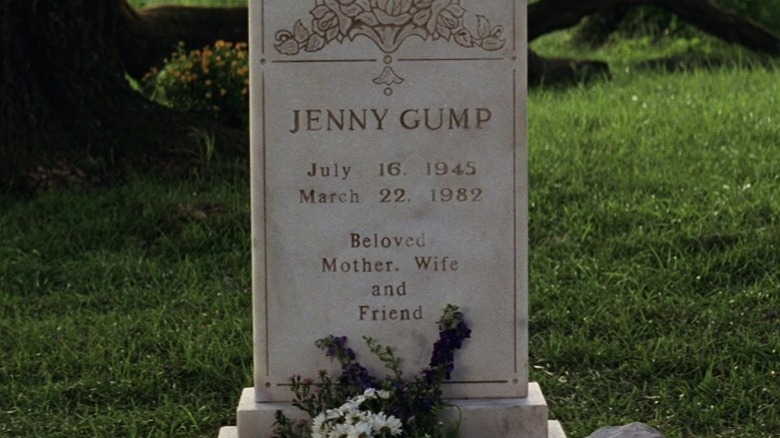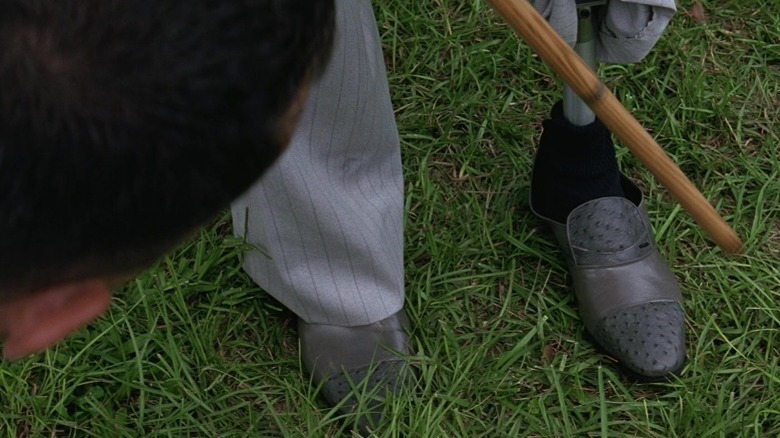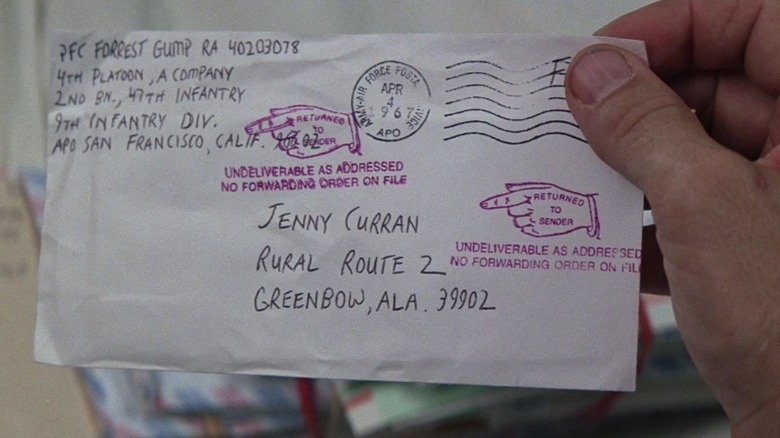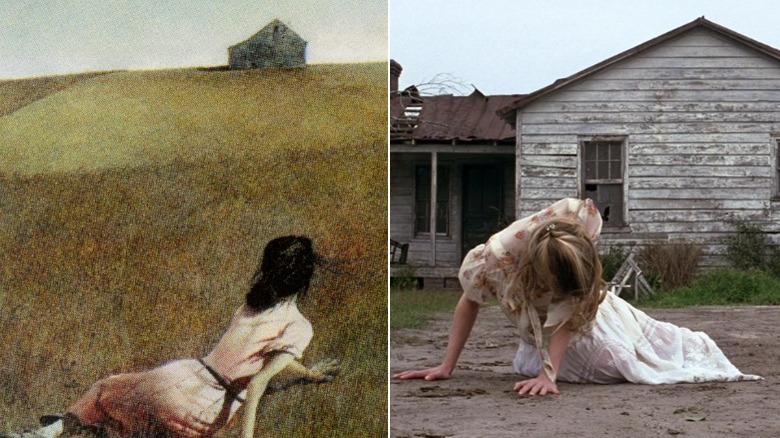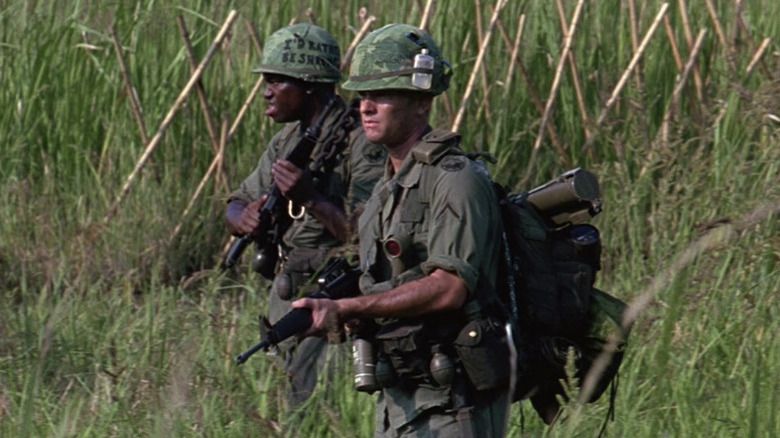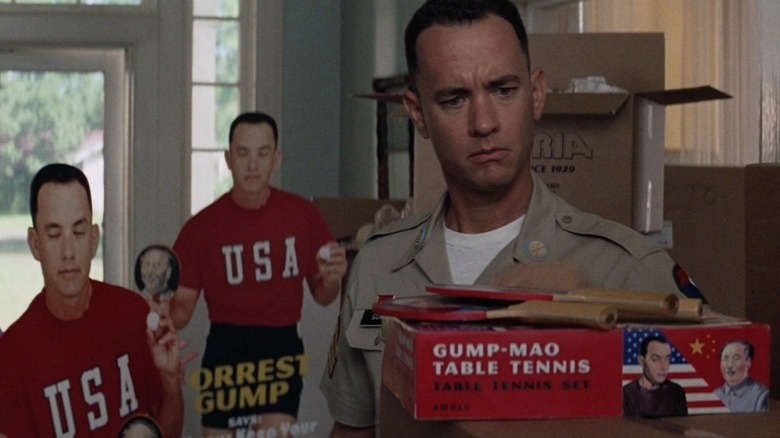Small Details You Missed In Forrest Gump
Robert Zemeckis' "Forrest Gump" is one of the most iconic and quintessential movies in American film history. It was a commercial hit upon its release, and a critical one too, as it won 50 awards during the 1995 season, including three Golden Globes and six Oscars (via IMDb). Tom Hanks won an Oscar for best actor in a leading role, and the film nabbed best picture over nominees like "Pulp Fiction" and "The Shawshank Redemption." There were reportedly plans for a sequel, but it was permanently shelved in the early 2000s.
The movie tells the story of Alabama native Forrest Gump (Hanks), as he navigates from adolescence through adulthood in mid-20th century America. He finds himself a party to some of the most momentous events of the century, including civil rights integration in Alabama, the Vietnam War, and the Watergate scandal.
The movie is known for spawning some of the most unforgettable quotes in movie history, like "Stupid is as stupid does," and "Life is like a box of chocolates; you never know what you're going to get." Yet, for all of the classic and quotable moments from "Forrest Gump," there are also a lot of subtle details that are hard to pick up -– even after a couple of watches. These are the small details you missed in "Forrest Gump."
Warning: spoilers ahead.
Tom Hanks' daughter Elizabeth is in the film
In one of the earliest scenes in "Forrest Gump," the titular character starts his first day of school in Alabama. The young Gump is shy because of his leg braces, and when he gets on the school bus, the other kids ostracize him and refuse to give him a place to sit. They all shake their heads at him or inform him that the open seats next to them are not open.
Yet, what most people do not realize is that one of the characters who refuses to give up their seat was actually played by Tom Hanks' daughter, Elizabeth Hanks. She's the girl wearing a red plaid dress, who shakes her head at Forrest. While she doesn't have any lines in this small role, she does have the distinction of appearing in one of the most important scenes in the movie since Forrest meets the love of his life, Jenny, moments later. This was not the only movie that Elizabeth and her father were in together: She also had another small role in Hanks' 1996 film "That Thing You Do," (via IMDb).
Forrest's football coach was a real person
A hilarious storyline in "Forrest Gump" is his brief but successful career as a kick returner for the University of Alabama's football team. He initially comes on the radar of the Alabama coaching staff after he inadvertently crashes their practice and outruns the entire team on the football field. He quickly becomes one of the best players in the country; he's so good that he is named an All-American and meets President John F. Kennedy.
One of the small details from his football career that almost never gets noticed is that his jersey is completely clean the entire time. All of his teammates and opponents are covered in grass and mud, but Forrest's jersey is still bright white and red. Presumably, this is because he is so fast that he outruns everyone whenever he is on the field and never gets tackled.
Another small detail that many fans may not realize is that the coach for Alabama in the movie is modeled on the University of Alabama's real life coach in the 1960s, Bear Bryant. He is distinguished in the movie by his famous checkered fedora, which became synonymous with his real life image. According to ESPN, Alabama was incredibly successful during Bryant's stint as head coach, winning the national championship in 1961, 1964, and 1965 — meaning that Forrest's character would have won two national championships ('64-'65) during his time there.
Jenny was born on the same day as the Atomic Trinity Tests
The character of Jenny is crucial to "Forrest Gump," and viewers get to watch her develop her liberal views in the face of a changing world. She channels Bob Dylan while working at a club after getting kicked out of college, and she becomes part of the counterculture movement protesting the Vietnam War in the 1960s. In fact, it's the March on Washington anti-war protest that reunites her with Forrest: She's attending the event when Forrest unwittingly agrees to make a speech.
One of the movie's small details that goes mostly overlooked is the connection between Jenny's politics and her birthdate. When we see her headstone at the end of the movie, it is revealed that she was born on July 16, 1945. This was the date of the first successful atomic bomb test — known as the Trinity Test — in Los Alamos, New Mexico (via History). The Trinity Test was the precursor to the nuclear bombings of Hiroshima and Nagasaki in August 1945, which brought a final end to WWII. It is unlikely that the date of her birth is merely a coincidence considering her portrayal throughout the movie, as it very well may be an homage to Jenny's liberal political views.
The song Free Bird is a call back for Jenny
In one of the most tragic scenes of the movie, Forrest discovers the abusiveness of Jenny's father and his alcoholism. One day, Jenny doesn't show up at school, so Forrest goes to her house. He finds her there with a bruised cheek, hiding out from her sleeping father. When her inebriated father suddenly wakes up, Jenny grabs Forrest by the hand and they flee into the thicket of her family's crop field. They get on the ground, and Jenny prays to God to "make me a bird, so I can fly far, far away from here."
Years later, Jenny finds herself in the midst of a severe depression, and she considers attempting suicide. While she stands on the ledge of a tall building, the Lynyrd Skynyrd song "Free Bird" starts to play louder and louder. The lyrics to the song reference being "free as a bird," which is a call back to the earlier scene in her father's backyard. The song is also about a lover who cannot commit to their partner long-term, which can be seen as a reference to Jenny's long-time reluctance to get into a relationship with Forrest.
If you or anyone you know is having suicidal thoughts, please call the National Suicide Prevention Lifeline by dialing 988 or by calling 1-800-273-TALK (8255).
Forrest carries Bubba differently than the other wounded soldiers
During his military service in the Vietnam War, Forrest Gump becomes best friends with fellow soldier Benjamin Buford "Bubba" Blue. The two of them instantly form a bond on the first day of boot camp, which carries over throughout their time in the service.
While fighting in Vietnam, Bubba gets severely wounded. Forrest realizes that Bubba is no longer by his side and goes back into the jungle to find his lost friend. He ends up rescuing several other soldiers before making it to Bubba, who dies in Forrest's arms just after he carries him out of the jungle.
What many people might not pick up on is how Forrest carries Bubba differently than the other soldiers. With the others, Forrest carries them over his shoulder. Yet with Blue, he carries him with both arms and cradles him, as he outruns the napalm blast from behind. It is exponentially physically harder to carry someone in your arms rather than over your shoulder, as you have to rely on only your arms rather than your entire upper body. Forrest has to carry Bubba that way because Bubba is gut-shot, but his character being able to do so shows the depth and power of their intimate relationship as friends.
The Veterans' group that Forrest speaks on behalf of is real
When Forrest Gump returns from his service in Vietnam, he goes to Washington to accept the Medal of Honor from President Lyndon B. Johnson. After a humorous exchange with the President, he decides to stay in the nation's capital to visit its various attractions and historic sites. However, while he is trying to explore the city, he gets mistaken for a protester and gets pushed into making an anti-war speech in front of a huge crowd of people at the Lincoln Memorial.
The organization that Forrest speaks on behalf of is the "Vietnam Veterans Against the War" (VVAW). It turns out, this was an actual organization of Vietnam veterans, who organized protests and spoke out against the continuing war throughout the 1960s. Six veterans initially formed the group in 1967, and it is still around today. According to their website, the group had over 30,000 members while the war was still going on, and members included active duty soldiers, who were still fighting in Vietnam.
The hurricane that Forrest navigated through happened in real life
A great subplot of "Forrest Gump" is Forrest's post-war career as a shrimp boat captain. At first, both Forrest and his first mate, Lieutenant Dan, have difficulty breaking into the industry. Although they have a good shrimping boat (paid for by Forrest's winnings playing ping-pong for the U.S. Army), they are unable to find consistent catches of crustaceans to make a profit.
One night, the two get caught in Hurricane Carmen while out on the open sea. The storm nearly destroys the boat and almost kills both Forrest and Lieutenant Dan, but they end up making it through unscathed. The rest of the shrimping industry in their area is absolutely devastated, leaving their "Bubba Gump Shrimp" boat as the only one still able to go out and fish. This results in a massive windfall for Bubba-Gump, catapulting them into the top echelon of the shrimp industry.
Yet, what many fans of the movie don't realize is that both Hurricane Carmen and the place where they dock their boat — Bayou la Batre — are real. According to the National Weather Service, Carmen was a 1974 hurricane that devastated areas along the Gulf of Mexico — although it mainly affected Louisiana and not Alabama, where this part of the film takes place. In addition, Bayou la Batre is a small community along the Mississippi Sound, which bills itself as the "Seafood Capital of Alabama."
Was Forrest in Project 100,000?
One of the most iconic storylines in "Forrest Gump” centers on his time serving in the army during the Vietnam War. In 1966, after graduating from the University of Alabama, Forrest decides to enlist after being approached by a recruiter. He immediately becomes one of his unit's best soldiers, "fitting into the army like one of them round pegs."
Yet earlier in the film, we find out that Gump has below-average intelligence. This has raised questions for some viewers, because though the army does not have an official IQ requirement, they do make all potential soldiers take an aptitude test in which they have to score above the minimum (via Military.com). This has led people to wonder if Forrest could have gotten a qualifying score due to his low IQ.
However, it might not have mattered at all. According to Lisa Hsiao in an article for Vietnam Generation, in 1966, Secretary of Defense Robert McNamara initiated "Project 100,000," a program that was designed to boost army numbers by lowering the testing standards required of enlistees (via La Salle University). Hsiao writes that the program predominantly targeted young men in the south who "came from economically unstable homes with non-traditional family structures," and "50% had IQs of less than 85." This all describes Forrest's character, making him a prime potential candidate for Project 100,000.
Jenny actually died on a Monday
The relationship between Forrest and Jenny is the backbone of the entire film. They meet on the bus on the first day of school, and Forrest instantly falls in love with her. He knows that she is an incredibly special person to him, but he struggles to understand the more tangible and intimate aspects of true love and companionship. For her part, Jenny constantly pushes him away from her, even though he is the only consistently positive force in her life.
By the end of the movie, Jenny and Forrest are deeply in love, but their marriage is tragically cut short by Jenny's terminal illness. In a heart-wrenching monologue, Forrest stands over her grave and weeps, telling her that she "died on a Saturday morning."
However, when we see her headstone, the day of her death is revealed to be March 22, 1982. According to Day in History, March 22, 1982 was actually a Monday. This is a relatively minor detail in the film, and does not affect the plot at all. But it is curious the creators did not bother to double check the date, especially considering the significance of her birthdate itself.
Lt. Dan's titanium alloy legs
Lieutenant Dan Taylor's character in "Forrest Gump" is a bit of an enigma. When we are first introduced to him, he comes across as a no-nonsense U.S. Army officer, who is both smart and an excellent leader. As the movie continues, Lieutenant Dan becomes increasingly complex, as we realize he has deep issues with inadequacy, spirituality, and intimacy. When he first reunites with Forrest after the war, he shows a grudging respect, but also often ridicules Forrest's attitude and perceived inferiority. In one of his most memorable barbs, Lieutenant Dan tells Forrest, "If you're ever a shrimp boat captain, that's the day I'm an astronaut!"
However, by the end of the movie, Lieutenant Dan has stopped making fun of Forrest since he sees him as a loyal and selfless individual worthy of respect and admiration. In his final appearance, Lieutenant Dan reveals that he has gotten prosthetics to replace his amputated legs, and he states they are "made of titanium alloy, just like on the space shuttle." This is somewhat of a call back to his earlier putdown of Forrest, with Lieutenant Dan somewhat fulfilling his promise — albeit in a roundabout way.
Jenny's maiden name
One aspect of Jenny's character that is almost completely overlooked in the movie is her maiden name. It is never mentioned by any of the characters, and you have to look pretty hard to find it. It is only seen a handful of times during the movie: We see it on the mailbox of her childhood house and also on the letters that get returned to Forrest when he is in the army hospital in Vietnam. Her last name is Curran, though she changes it to Gump after they get married. She is also listed in the credits as Jenny Curran, but it takes a very good eye to pick up on her last name during the actual film.
It is unclear why Jenny's maiden name is nearly omitted from the film, and whether or not that was a conscious choice, but it does add an interesting wrinkle to her character. The question behind her last name is somewhat of a parallel with the mystery of the majority of her character's life. The audience only really gets to see bits and snippets of Jenny's travels without Forrest, with one single scene covering a decade of her travels. It's possible the mystery of her last name is intended as a metaphor for the enigma of her character as a whole.
Jenny references a famous painting
Throughout "Forrest Gump," one of the biggest symbols of negativity and abuse is Jenny's childhood home. We first see the house when Forrest goes to find Jenny after she misses school, and it becomes synonymous with her abuse from then on. We do not see the house again until both Forrest and Jenny are adults and they pass by it on a walk. Jenny gets upset by the sight of her former home, where she experienced so much pain as a child.
In a rage, she starts throwing rocks at the house in a futile attempt to knock it down. Finally, she falls down in a fit of disgust and pain. There's a shot of Jenny on the ground in front of the house, which strongly resembles Andrew Wyeth's 1948 painting "Christina's World." Wyeth's portrait features a young girl lying on the ground in front of a house with a dreary sky as the background. The subject of the painting was Wyeth's neighbor, Anna Christina Olson, who had polio, and is more an encapsulation of her psychological state of perseverance rather than physical struggles (via The Museum of Modern Art). Jenny in "Forrest Gump" also pushes through her trauma to live her life, and the visual connection between Jenny in this scene and Wyeth's "Christina's World" highlights that quality.
If you or someone you know may be the victim of child abuse, please contact the Childhelp National Child Abuse Hotline at 1-800-4-A-Child (1-800-422-4453) or contact their live chat services.
Bubba's helmet cover in Vietnam
If there is one thing that fans of "Forrest Gump" remember about Benjamin Buford "Bubba" Blue, it is his love for all things shrimp-related. From the first second Forrest meets Bubba on the bus to boot camp, all Bubba talks about is shrimp. Not just about eating it, but about catching it, cooking it, selling it, and just about anything you can think of. He names dozens of different ways to prepare shrimp, and lists them all in succession to an attentive but indifferent Forrest.
Bubba's character is so enamored with shrimp that he even puts it on the side of his army helmet. Most people miss it, but during the scenes where it shows Bubba patrolling in Vietnam, you can see the phrase "I'd Rather Be Shrimping" written in black ink. According to Military.com, troops writing on their helmets was actually a relatively common thing during the war, and they could write pretty much whatever they wanted. It's telling that Bubba chose to write about shrimp on his helmet cover, as it shows just how much he truly loved the crustacean industry.
Forrest's eyes are closed every time his picture is taken
Another relatively obscure detail that most people miss in "Forrest Gump" is that whenever Forrest gets his picture taken, his eyes are closed. The first instance occurs immediately after he graduates from the University of Alabama, when Forrest closes his eyes just as he and mother are having their picture snapped. It is also plainly noticeable in all of the cardboard cutouts of Forrest playing ping-pong, as well in the picture of him on the cover of Fortune Magazine.
Forrest finds himself in the midst of some of the largest and most momentous events of the 1950s-1970s, but he doesn't always recognize the significance of what he experiences. For example, while Forrest fights in the Vietnam War, he remains unaware of the larger implications of the geo-politics of the war. And despite growing up in the South, he doesn't see why desegregation is an issue in Alabama in the early 1960s.
One interpretation of Forrest closing his eyes is that it is a metaphor for his difficulty understanding the social and political dynamics of 20th-century America. It is almost as if he is closing his eyes to escape the larger consequences and ramifications of his actions within American society.
